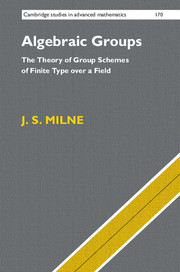Book contents
- Frontmatter
- Contents
- Preface
- Introduction
- 1 Definitions and Basic Properties
- 2 Examples and Basic Constructions
- 3 Affine Algebraic Groups and Hopf Algebras
- 4 Linear Representations of Algebraic Groups
- 5 Group Theory; the Isomorphism Theorems
- 6 Subnormal Series; Solvable and Nilpotent Algebraic Groups
- 7 Algebraic Groups Acting on Schemes
- 8 The Structure of General Algebraic Groups
- 9 Tannaka Duality; Jordan Decompositions
- 10 The Lie Algebra of an Algebraic Group
- 11 Finite Group Schemes
- 12 Groups of Multiplicative Type; Linearly Reductive Groups
- 13 Tori Acting on Schemes
- 14 Unipotent Algebraic Groups
- 15 Cohomology and Extensions
- 16 The Structure of Solvable Algebraic Groups
- 17 Borel Subgroups and Applications
- 18 The Geometry of Algebraic Groups
- 19 Semisimple and Reductive Groups
- 20 Algebraic Groups of Semisimple Rank One
- 21 Split Reductive Groups
- 22 Representations of Reductive Groups
- 23 The Isogeny and Existence Theorems
- 24 Construction of the Semisimple Groups
- 25 Additional Topics
- Appendix A Review of Algebraic Geometry
- Appendix B Existence of Quotients of Algebraic Groups
- Appendix C Root Data
- References
- Index
Preface
Published online by Cambridge University Press: 25 October 2017
- Frontmatter
- Contents
- Preface
- Introduction
- 1 Definitions and Basic Properties
- 2 Examples and Basic Constructions
- 3 Affine Algebraic Groups and Hopf Algebras
- 4 Linear Representations of Algebraic Groups
- 5 Group Theory; the Isomorphism Theorems
- 6 Subnormal Series; Solvable and Nilpotent Algebraic Groups
- 7 Algebraic Groups Acting on Schemes
- 8 The Structure of General Algebraic Groups
- 9 Tannaka Duality; Jordan Decompositions
- 10 The Lie Algebra of an Algebraic Group
- 11 Finite Group Schemes
- 12 Groups of Multiplicative Type; Linearly Reductive Groups
- 13 Tori Acting on Schemes
- 14 Unipotent Algebraic Groups
- 15 Cohomology and Extensions
- 16 The Structure of Solvable Algebraic Groups
- 17 Borel Subgroups and Applications
- 18 The Geometry of Algebraic Groups
- 19 Semisimple and Reductive Groups
- 20 Algebraic Groups of Semisimple Rank One
- 21 Split Reductive Groups
- 22 Representations of Reductive Groups
- 23 The Isogeny and Existence Theorems
- 24 Construction of the Semisimple Groups
- 25 Additional Topics
- Appendix A Review of Algebraic Geometry
- Appendix B Existence of Quotients of Algebraic Groups
- Appendix C Root Data
- References
- Index
Summary
For one who attempts to unravel the story, the problems are as perplexing as a mass of hemp with a thousand loose ends.
Dream of the Red Chamber, Tsao Hsueh-Chin.This book represents my attempt to write a modern successor to the three standard works, all titled Linear Algebraic Groups, by Borel, Humphreys, and Springer. More specifically, it is an exposition of the theory of group schemes of finite type over a field, based on modern algebraic geometry, but with minimal prerequisites.
It has been clear for fifty years that such a work has been needed. When Borel, Chevalley, and others introduced algebraic geometry into the theory of algebraic groups, the foundations they used were those of the period (e.g., Weil 1946), and most subsequent writers on algebraic groups have followed them. Specifically, nilpotents are not allowed, and the terminology used conflicts with that of modern algebraic geometry. For example, algebraic groups are usually identified with their points in some large algebraically closed field K, and an algebraic group over a subfield k of K is an algebraic group over K equipped with a k-structure. The kernel of a k-homomorphism of algebraic k-groups is an object over K (not k) which need not be defined over k.
In the modern approach, nilpotents are allowed, an algebraic k-group is intrinsically defined over k, and the kernel of a homomorphism of algebraic groups over k is (of course) defined over k. Instead of identifying an algebraic group with its points in some “universal” field, it is more convenient to identify it with the functor of k-algebras it defines.
The advantages of the modern approach are manifold. For example, the infinitesimal theory is built into it from the start instead of entering only in an ad hoc fashion through the Lie algebra. The Noether isomorphism theorems hold for algebraic group schemes, and so the intuition from abstract group theory applies. The kernels of infinitesimal homomorphisms become visible as algebraic group schemes.
Information
- Type
- Chapter
- Information
- Algebraic GroupsThe Theory of Group Schemes of Finite Type over a Field, pp. xv - xviPublisher: Cambridge University PressPrint publication year: 2017
